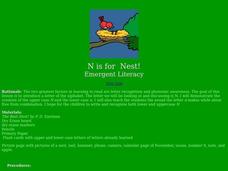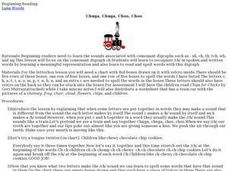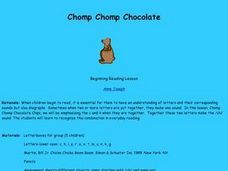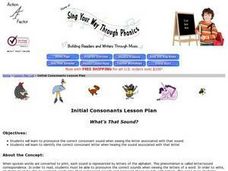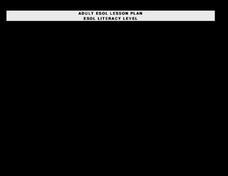Meadows Center for Preventing Educational Risk, University of Texas at Austin
Lesson 2 - Consonant-Vowel-Consonant Words
Closed syllable words contain short vowel sounds. A phonics lessons introduces readers to consonant-vowel-consonant words. Guided instruction introduces the words with a series of dictation activities, and then learners practice reading...
Curated OER
Circle The Words
In this initial consonant worksheet, students read 25 words. Students circle the words that start with l, m, p, or r. Then students answer 6 questions about the words.
Curated OER
I Say You Say
Students practice switching initial consonant sounds to make rhyming words. They identify the difference between rhyming words is in the initial sound. Students practice various rhyming phrases and create their own rhyming pairs.
Curated OER
CH-ch-ch-ch, CH-ch-ch-ch, CHOO-CHOO!
Students identify the digraphs in written and spoken language. After a brief discussion of the combinations of /c/ and /h/ that comprise th /ch/ digraph, students practice identifying initial and final placement of the digraph /ch/ in...
Curated OER
Phoneme Segmenting Accuracy
Take your kindergartners on a journey to the mythical planet Paz where residents segment words into phonemes, touching parts of their arm with each sound. This physical response to phoneme segmenting will appeal to your physical learners...
Curated OER
Chuga, Chuga, Choo, Choo
Students identify the digraphs in written and spoken language. After a brief discussion on the combinations of letters that comprise digraphs, students practice identifying initial and final placement of the digraph /ch/ in words and...
Curated OER
I'm going to chase you
First graders identify the digraphs in written and spoken language. After a brief discussion of the combinations of /c/ and /h/ that comprise the /ch/ digraph, 1st graders practice identifying initial and final placement of the digraph...
Curated OER
Champions of /Ch/
Students identify the digraph /ch/ in written and spoken language. Students practice identifying initial and final placement of the digraph /ch/ in words by identifying pictures containing the sound. They decode and spell words in with...
Curated OER
N is for Nest
Students identify the letter and phoneme /n/ in written and spoken language. Students practice the production of the /n/ sound through listening and matching activities. They identify the initial placement of the letter and sound using a...
Curated OER
-- Family Word Slide (Circular)
In this vocabulary worksheet, students analyze the "--ake" rhyming pattern by making a word slide. Students cut slits in the laminated word ending piece and slide the beginning consonants strip to make 12 new words.
Curated OER
Max's Magic Magnets
Pupils identify the letter and phoneme /m/ in written and spoken language. Students practice the production of the /m/ sound through tongue twisters and stories. They identify the initial placement of the letter and sound using a picture...
Curated OER
Chuga Chuga Choo Choo
First graders identify the digraph /ch/ in written and spoken language. After a brief discussion of the independent and combined sounds of the phonemes /c/ and /h/ students practice identifying initial and final placement of the new...
Curated OER
Don't Wake Mama
Students identify the digraph /sh/ in written and spoken language. After a brief discussion of the independent and combined sounds of the phonemes /s/ and /h/ students practice identifying initial and final placement of the new digraph...
Curated OER
Choo, Choo, words that say /Ch/!
Students identify the digraph /ch/ in written and spoken language. After a brief discussion of the independent and combined sounds of the phonemes /c/ and /h/ students practice identifying initial and final placement of the new digraph...
Curated OER
Chomp Chomp Chocolate
Students identify the digraph /ch/ in written and spoken language. Students practice identifying the initial and final placement of the digraph /ch/ in words by identifying pictures containing the sound. They read a decodable story...
Curated OER
Shhhhh, the Baby's Asleep
Students identify the digraph /sh/ in written and spoken language. After a discussion of the independent and combined sounds of the phonemes /s/ and /h/ students practice identifying initial and final placement of the new digraph /sh/ in...
Curated OER
Chug Choo Choo
First graders identify the digraph /ch/ in written and spoken language. After a brief discussion of the independent and combined sounds of the phonemes /c/ and /h/ students practice identifying initial and final placement of the new...
Curated OER
The Big City
Students explore structures in a big city. In this big city lesson plan, students become familiar with vocabulary about big cities through songs graphs, and hands-on art. Students practice phonic sound /M/.
Curated OER
Sing Your Way Through Phonics Lesson Plan "What's That Sound?"
Students practice pronouncing the correct consonant sound.
Curated OER
First Letter Changes
Students use the books of Eric Carle to change the first letter in a word to see a new word. In this phonics lesson plan, students change the beginning letters in poems and books.
Curated OER
ESOL: Health and Nutrition
Learners explore the four food groups and how they contribute to one's health. They identify the four food groups and create a poster of the four food groups with pictures. They present their posters to the class and practice answering...
Curated OER
Government and Community Resources
Adult learners, with the assistance of flash/picture cards, explore a variety of United States holidays and social customs: Labor Day, Halloween, Thanksgiving, Hanukkah, Christmas, and more. In addition, they draw pictures illustrating...
Curated OER
Telephone Communication
Learners role-play telephone conversations. They view a video of a telephone conversation and discuss the vocabulary used during the conversation. They practice conversations and substitute responses.
Curated OER
ESOL: Time and Money
Students study the parts of an analog and digital clock. They create paper clocks to identify telling time to the hour, half-hour, and quarter past and quarter after. They practice tellng time in pairs.








